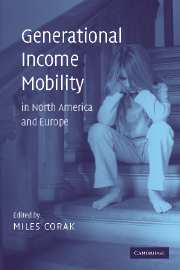Book contents
- Frontmatter
- Contents
- List of figures
- List of tables
- List of contributors
- Preface
- 1 Generational income mobility in North America and Europe: an introduction
- 2 A model of intergenerational mobility variation over time and place
- 3 Equal opportunity and intergenerational mobility: going beyond intergenerational income transition matrices
- 4 Intergenerational mobility for whom? The experience of high- and low-earning sons in international perspective
- 5 What do trends in the intergenerational economic mobility of sons and daughters in the United States mean?
- 6 Changes in intergenerational mobility in Britain
- 7 Intergenerational mobility in Britain: new evidence from the British Household Panel Survey
- 8 Non-linear patterns of intergenerational mobility in Germany and the United States
- 9 Family structure and labor market success: the influence of siblings and birth order on the earnings of young adults in Norway, Finland, and Sweden
- 10 New evidence on the intergenerational correlation in welfare participation
- 11 Intergenerational influences on the receipt of unemployment insurance in Canada and Sweden
- 12 Unequal opportunities and the mechanisms of social inheritance
- Index
- References
4 - Intergenerational mobility for whom? The experience of high- and low-earning sons in international perspective
Published online by Cambridge University Press: 22 September 2009
- Frontmatter
- Contents
- List of figures
- List of tables
- List of contributors
- Preface
- 1 Generational income mobility in North America and Europe: an introduction
- 2 A model of intergenerational mobility variation over time and place
- 3 Equal opportunity and intergenerational mobility: going beyond intergenerational income transition matrices
- 4 Intergenerational mobility for whom? The experience of high- and low-earning sons in international perspective
- 5 What do trends in the intergenerational economic mobility of sons and daughters in the United States mean?
- 6 Changes in intergenerational mobility in Britain
- 7 Intergenerational mobility in Britain: new evidence from the British Household Panel Survey
- 8 Non-linear patterns of intergenerational mobility in Germany and the United States
- 9 Family structure and labor market success: the influence of siblings and birth order on the earnings of young adults in Norway, Finland, and Sweden
- 10 New evidence on the intergenerational correlation in welfare participation
- 11 Intergenerational influences on the receipt of unemployment insurance in Canada and Sweden
- 12 Unequal opportunities and the mechanisms of social inheritance
- Index
- References
Summary
Researchers have devoted considerable attention to understanding and overcoming a number of methodological concerns needed to obtain an unbiased estimate of the degree of intergenerational mobility. Solon (1992) and Zimmerman (1992) highlight measurement errors associated with the use of annual as opposed to longer-term measures of earnings; Jenkins (1987), Reville (1995), and Grawe (2001b) point to related problems associated with the age at which parents and children are observed; and countless studies using multiple data sets have attempted to find “the number” that best estimates intergenerational mobility in earnings and income. But a new line of literature seeks to move beyond strict measurement in an effort to better understand the transmission of economic status. Even if estimates are biased, if the biases are similar across groups or across time, then the results may yet be useful. For instance, Couch and Lillard in Chapter 8 look for cross-country differences in regression non-linearities and the authors of Chapters 5 and 6 examine trends in mobility estimates over time. In fact, as Grawe and Mulligan (2002) discuss, an entire literature has developed to determine the extent to which credit constraints affect intergenerational correlations.
This chapter joins this endeavor, addressing several largely unexplored questions. The first is perhaps the most basic: what exactly is meant when an economy is said to be open or to exhibit equality of opportunity?
- Type
- Chapter
- Information
- Generational Income Mobility in North America and Europe , pp. 58 - 89Publisher: Cambridge University PressPrint publication year: 2004
References
- 51
- Cited by



